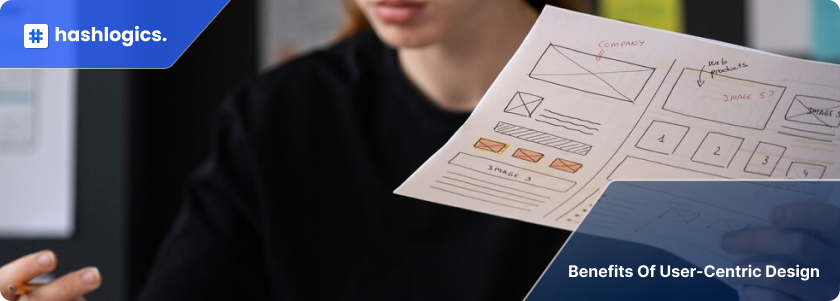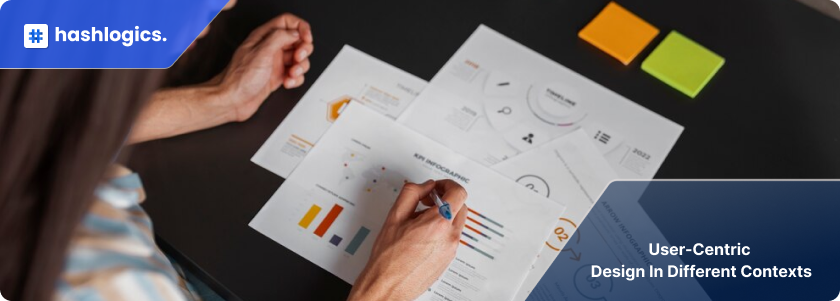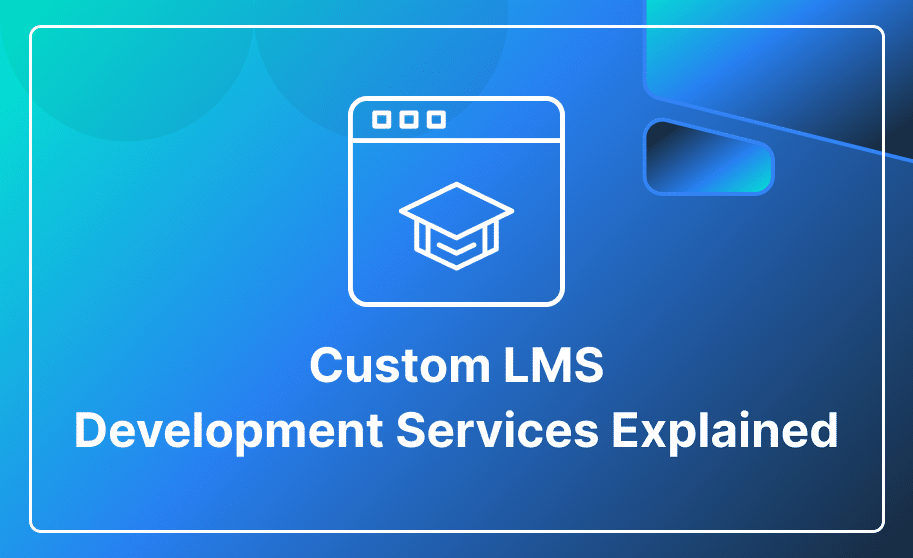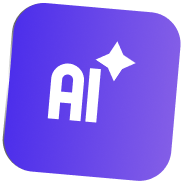User-Centered Design (UCD) is the process of creating a tool, such as creating a user interface of a website or SaaS application, with a focus on how it will be understood and utilized by human users.
Applying User-Centered design to a system design results in a product that offers a more efficient, satisfying, and user-friendly experience. Consequently, this leads to increased sales and enhanced customer loyalty.
User-centered design centers on crafting products tailored to specific user needs, whereas design thinking comprises a broader approach involving iterative problem-solving to tackle complex challenges.
In this blog, we will discuss the principles of user-centric design, along with its benefits, challenges, tools, and methodologies that shape seamless user experiences.
User-Centric Design Principles:
- Empathy:
The key principle of User-Centric design is empathy. By understanding the user’s needs, challenges, and motivations, designers create solutions that truly resonate. This approach lays the foundation for designs that address real-life scenarios.
- Usability:
The essence of User-Centric designs lies in creating visually appealing and effortlessly usable products. Usability is a key – making products that are intuitive, easy to navigate, and accessible to a broad audience.
- User Research:
User research provides valuable insights into user’s behavior, preferences, and pain points. By conducting quantitative and qualitative research, professionals gather insights into their target audience to make data-driven decisions. This continuous exploration ensures that design choices align with user expectations, ultimately leading to a successful and user-friendly product.
- Iterative Design:
The journey towards a flawless user experience is paved with iteration. This cycle of refinement allows for ongoing improvement of the design, ensuring that the design aligns closely with user expectations and needs through successive iterations.
- Inclusivity:
Inclusivity is a fundamental principle of User-Centric Design. Inclusivity in design entails designing for a diverse range of users, considering different abilities, backgrounds, and preferences to ensure the end product is accessible and user-friendly for a wide range of users.
Benefits of User-Centric Design:
- Improved User Satisfaction and Engagement:
User satisfaction and engagement are the crucial outcomes of user-centric design. By understanding and catering to user preferences, we create experiences that make users satisfied and keep them actively involved. This focus on user satisfaction fosters loyalty and contributes to the overall success and competitiveness of the product in the market.
- Increased accessibility and usability:
In User-Centric design, making things accessible and easy to use are fundamental elements for achieving success. By prioritizing user needs, products become more user-friendly and accessible to a diverse audience.
- Better business outcomes:
User-centered design leads to improved business outcomes, including higher conversion rates and enhanced customer loyalty. By aligning user’s needs and preferences, businesses create experiences that resonate, leading to increased customer satisfaction and loyalty.

Implementing User-Centric Design:
Best Practices for Incorporating User Feedback into The Design Process:
To successfully implement user-centric design, it’s important to establish robust feedback loops. The best practices include:
- Schedule regular and timely feedback sessions to gather feedback at different stages of the design process.
- Gather feedback from diverse groups of users to encompass a wide range of perspectives.
- Use data analytics to complement qualitative feedback.
Tools and Methodologies for User Research and Testing
Choosing the right tools and methodologies can significantly impact the efficiency of the design process. Key considerations include:
- Use tools to create detailed user personas based on demographic and psychographic data.
- Employ prototyping tools for creating interactive and iterative design prototypes.
- Explore usability testing platforms to conduct remote or in-person user testing.
Examples of Successful User-Centric Designs
Some notable examples of successful user-centric designs are:
- Apple:
The design process for a website or mobile app should prioritize rapid access to information. Apple’s web pages are the perfect illustration of this principle.
- Spotify:
Spotify stands as the leading example of turning user needs and desires into an exceptionally valuable product. Spotify developed its services to offer users a more convenient way to enjoy music.
In the realm of human-centered design, UI (User interface) creates visually intuitive designs, and UX (user experience) ensures seamless and enjoyable user journeys.
Challenges and Solutions in User-Centric Design
Let’s explore three challenges and their solutions in user-centric design.
Challenge:
Balancing business goals with user needs.
Solution:
It requires implementing the user-centric approach into business strategies and aligning user needs with user preferences through comprehensive research.
Challenge:
Users come with different backgrounds, preferences, and abilities. Crafting a design to meet the requirements of the broader user base can be challenging.
Solution:
It requires thorough user research to identify diverse user personas and consider accessibility features.
Challenge:
Ensuring continuous user involvement throughout the design process can be challenging as projects progress and priorities change.
Solution:
Creating a continuous feedback loop is imperative. Regularly seek user input through surveys, usability testing, and feedback sessions.

User-Centric Design in Different Contexts:
User-centered design principles act as the guiding force for creating seamless user experiences across diverse mediums. Let’s explore how these principles apply in various contexts, including web design, mobile app design, and software development.
Implementing user-centric design in web development involves creating intuitive navigation, ensuring responsive layouts, and optimizing content accessibility. The objective is to provide a cohesive and engaging online experience that caters to diverse user expectations.
Within the domain of mobile apps, user-centric design is all about making things simple and user-friendly. Whether it’s intuitive gestures or streamlined navigation, mobile app design guarantees users a seamless interaction with the application, regardless of the device’s size, fostering the balance integration of functionality and convenience.
In software development, things become complex when functionality meets user interface design. User-centric design principles assist developers in creating robust and user-friendly software. It involves understanding user workflows, simplifying complex processes, and maintaining consistency to enhance usability.
In user-centric design, understanding software and SaaS design across industries is crucial. Software design shapes user interactions, and SaaS design transforms service delivery. From healthcare to finance, industries benefit from customized UI/UX, ensuring seamless user experiences and optimized interactions.
Ethical Considerations in User-Centric Design:
Respecting user privacy is paramount in user-centric design. In today’s digital interactions, collecting user data is inevitable but must be done responsibly. This ethical commitment requires transparent communication about the purpose of data collection, its usage, and securing explicit user consent.
User-centric design rejects manipulative strategies. The focus should be on empowering users with transparent choices and honest information. Creating designs that genuinely serve user needs without coercive tactics, fostering relationships founded on trust and mutual respect.
Future of User-Centric Design:
In the fast-changing world, one thing is clear: the future belongs to those who embrace customer-centered design and wholeheartedly adopt human-centered designs.
Let’s talk about where User-Centric Design is headed by looking at emerging trends like AI and VR and how evolving user expectations continue to shape design strategies.
AI is changing the way users engage with technology. From personalized suggestions to predictive insights, AI elevates user experiences by understanding preferences and adjusting in real time. The integration of AI in design processes ensures more intuitive and responsive products.
- Virtual Reality (VR):
Virtual Reality introduces a new era in user interaction. VR potential lies not only in gaming and entertainment but also in revolutionizing the way users interact with the digital environment. It provides exciting opportunities for innovative and user-centric designs.
Resources and Further Reading:
Visit our websites for a wealth of insights, from user-centered design services to thought-provoking blogs.
Conclusion:
User-centric design is not a one-size-fits-all; it’s a dynamic and adaptive approach. By covering empathy, usability, user research, iterative design, and inclusivity, designers can create products that not only meet the user’s expectations but also foster long-term connections.
By going along with emerging trends and aligning user strategies with user demands for seamless experiences and personalized interactions, designers can steer towards a future where user-centricity continues to be the key success of design excellence. In today’s evolving landscape, staying ahead means anticipating trends and actively shaping the future of design.
“Revolutionize your Approach – Start Implementing Human-Centered Solutions!”














